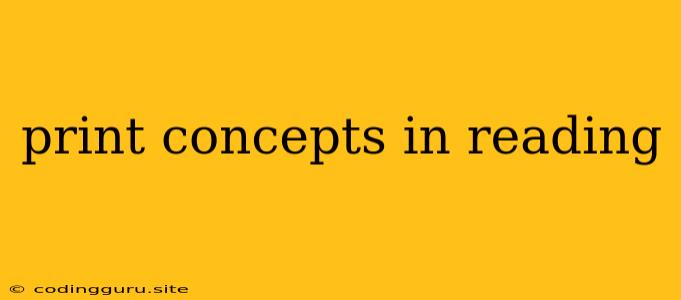Delving into the World of Print Concepts in Reading
Reading is a complex process, requiring a multitude of skills to decipher the written word and understand its meaning. One key aspect of this process is understanding print concepts – the fundamental knowledge about how print works. This includes recognizing the different components of print like letters, words, and sentences, understanding how they are arranged, and the connection between spoken and written language.
What are Print Concepts in Reading?
Print concepts are the foundational building blocks that enable children to understand and use written language effectively. They are the basic rules and conventions of written language, including:
- Directionality: Understanding that print is read from left to right and top to bottom.
- Letter Recognition: Identifying and naming individual letters of the alphabet.
- Word Boundaries: Recognizing that spaces separate words.
- First and Last Letter Recognition: Identifying the first and last letter in a word.
- Matching Letters: Recognizing the same letter in different fonts and sizes.
- Book Handling: Knowing how to hold a book, turn pages, and find the front and back cover.
- Print Awareness: Recognizing that print carries meaning and is used in different ways (e.g., signs, menus, labels).
Why are Print Concepts Important?
Developing print concepts is crucial for young learners as they embark on their reading journey. Here's why:
- Foundation for Literacy: They are the building blocks of literacy, enabling children to decode and understand written language.
- Decoding Skills: Understanding print concepts helps children recognize letter patterns and sound-letter relationships, which are essential for decoding words.
- Reading Comprehension: Strong print concepts contribute to reading comprehension by enabling children to focus on the text and extract meaning from the words on the page.
- Motivation and Engagement: A solid understanding of print concepts helps children feel more confident and engaged in reading activities.
How Can We Develop Print Concepts in Children?
Here are some effective strategies to foster print concepts in young learners:
- Interactive Reading: Engage children in interactive reading sessions, pointing out words, emphasizing letter sounds, and asking questions about the text.
- Environmental Print: Highlight the presence of print in everyday environments, such as signs, labels, and packaging. Discuss the meaning of these words and their importance.
- Games and Activities: Introduce games and activities that focus on letter recognition, word boundaries, and directionality. Use alphabet blocks, puzzles, and matching games.
- Writing Experiences: Provide opportunities for children to explore writing, using different writing tools and materials. Encourage them to practice forming letters and writing their name.
- Reading Aloud: Read aloud to children regularly, modeling fluent reading and pointing out the connection between the spoken and written word.
- Early Literacy Resources: Utilize early literacy resources such as picture books, alphabet charts, and learning games.
Examples of Print Concepts in Action
Here are some examples of how print concepts can be used in everyday situations:
- Pointing to Words: While reading a story, point to each word as you read it aloud, emphasizing the directionality of print.
- Labeling Objects: Label common objects around the classroom or home with their corresponding words, helping children connect the object with its written form.
- Interactive Writing: Create a shared writing experience by allowing children to "write" their name or a simple word by tracing letters or using a finger to write on the board.
Conclusion
Understanding and developing print concepts is vital for children's literacy development. By fostering a strong foundation in these essential skills, we empower young learners to become confident and successful readers. Through interactive reading, playful learning activities, and exposure to print in everyday environments, we can ignite a love of reading and unlock the world of language for children.
